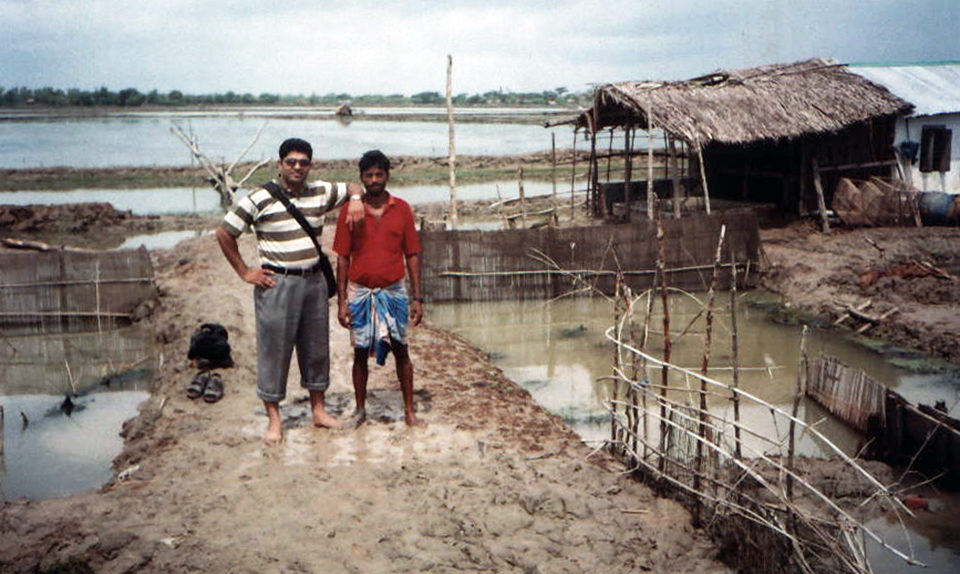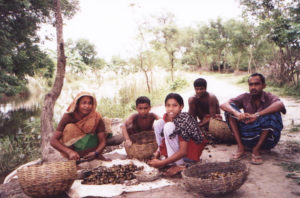Dispelling some myths about impacts

Bangladesh is one of the top-10 shrimp-producing countries of the world. Bangladesh’s shrimp are mainly exported to the European Union, the United States, Japan and some Middle Eastern countries. The exports continue to be the country’s second-largest foreign exchange earner after ready-made garments, earning around $500 million yearly. The sector provides two million jobs that support more than five million people in Bangladesh.
Subsistence fishermen have caught shrimp for local consumption in Bangladesh for hundreds of years. However, the beginning of the present export-oriented shrimp culture dates back to the late 1960s, when a number of fish-freezing plants were set up in Chittagong and Khulna. Since the 1980s, there has been a dramatic increase in shrimp farming, especially in the coastal areas, where this has been termed the “Blue Revolution.” The Department of Fisheries estimates that there are approximately 250,000 ha of coastal shrimp farms producing an average of 100,000 metric tons of shrimp annually.
Sustainability
Discourse related to commercial shrimp farming has gone on since its inception. While there are different positions within non-governmental organizations and intellectual communities – ranging from total opposition to strong promotion of commercial shrimp – one thing all groups call for is sustainability.
Bangladesh has progressed enormously along a path toward greater sustainability. The author’s ongoing research on Bangladesh’s shrimp aquaculture has seen several major transformations over time. Three main periods of commercial shrimp farming can be noted in Bangladesh: the era of resistance, the era of ambivalence and the era of normalization.
Questionable start
In its early years, shrimp aquaculture in Bangladesh was largely sustained through a complex system of political patronage involving corrupt officials, local politicians and a handful of drug dealers. They were lured by short-term profit at the expense of the local people. In various instances, shrimp producers forcefully evicted small and marginal rice farmers, expropriating government-owned lands and converting a portion of Sundarban mangrove forest to shrimp ponds.
With the help of non-governmental organizations (NGOs), the affected communities raised resistance against shrimp aquaculture that continued until the end of the 1990s. The resistance amalgamated with other social justice movements and transcended national borders. Some pioneers in this global resistance movement included Greenpeace, the Environmental Justice Foundation and Nijera Kori, which continue to oppose shrimp farming despite the industry’s various positive transformations over the last decade.
Environmental, social issues
Local and international environmental activists have succeeded in drawing international attention to the issue of environmental and social damage caused by the shrimp industry. In response, Bangladeshi authorities, along with donor agencies, established a series of environmental agendas as well as inspection and quality-control institutions to demonstrate adherence to the principle of environmentally sound shrimp aquaculture.
Because of a long series of institutional changes and monetary and technical help for the new entrepreneurs and farmers, people began to see shrimp aquaculture in a more ambivalent way. As foreign cash began to flow into the local economy, many rice farmers began to switch to shrimp aquaculture on a trial basis. Overall, a strong local ambivalence persisted until 2003.
Some NGOs then began to shift their activities from resistance to cooperation, and many local farmers changed their form of subsistence from rice to shrimp. Although this era alienated some NGOs, shrimp aquaculture became more widely accepted by the local population as, among many other reasons, foreign cash invigorated the local economy.
The main issue of concern became not to oppose shrimp and revert back to rice, but to ensure the quality and traceability required by the shrimp buyers. With the introduction of HACCP and other social and environmental measures, the practices of shrimp culture also changed.
The worst forms of social and environmental violence – the arguable issues for NGO resistance – have become things of the past. While there are still instances of corruption and other unsustainable practices that also occur outside Bangladesh, almost all shrimp farmers – many of them previous paddy farmers – think shrimp farming is profitable for and beneficial to the local community.
Myths
While some environmental and social concerns related to shrimp still remain, many contentious issues have gradually become myths.
Myth 1: Raising shrimp creates less employment than farming paddy.
In fact, shrimp have created more opportunities than paddy. Land currently used for shrimp was previously barren with no cultivation or seasonal paddy fields with less production and fewer economic and social returns. Freshwater prawn culture is often alternated with paddy in freshwater areas. A huge array of shrimp-related jobs have emerged that paddy could not generate.
Myth 2: Shrimp farming creates more salinity than paddy.
Water on the southern coasts is brackish rather than saline. Brackish water is a mixture of saline water from the sea and freshwater from rivers. Due to the Farakka Barrage and other barriers to the flow of freshwater from the Himalayas, the hindered formation of brackish water has had tremendous impacts on the ecosystem of the coastal areas, including Sunderban.
“Shrimp may contribute to salinity, but it is not the main reason, as depicted by many,” said the president of the Bangladesh Shrimp Farmers Association.
Myth 3: Shrimp aquaculture is disastrous to women.
The development of shrimp farming has created more opportunities for women than they had before. Despite the fact that women are still marginalized compared to their male counterparts, a comparison of women’s current position in society with their state before the advent of commercial shrimping shows that shrimp elevated their status, widened opportunities and subverted the traditional rigid gender division of labor.
New industry
Shrimp farming has also made some previously unused natural resources useful and commoditized. For example, the snails fed to domestic ducks in rural Bangladesh are now used for shrimp feed, especially in freshwater prawn farming in the Khulna region. Mainly women and children collect snails and sell them to dealers.
The snail regime generates additional jobs, such as those for people engaged to bring the snails by van, bullock cart or small truck to the shrimp pond areas. Women in the farm areas break the snails and sell the shells in the market for use in preparing poultry feed.
Women can earn 50 to 80 takas (about $0.60 to $1) daily by breaking snails. A mother of four reported, “I have been breaking snails for the last 12 years and earning 75 takas on an average almost every day.” She also mentioned that she did not have any other task to earn money until 12 years ago.
‘White gold’

Many young entrepreneurs have managed to reap the financial harvest of snail production, as reflected in one man’s story.
“I became ‘zero to hero’ because of shrimp,” one entrepreneur said. “I had nothing in society – no money, no regard, no prestige. I was from a poverty-ridden family. I had no social position, no ‘say’ in society. I ventured into shrimp cultivation. I did everything on my own. I’m now proud of myself.
“Shrimp has changed my life. I now have 950 bighas of ghers in a joint partnership with two other young entrepreneurs. We already earned 400,000 takas ($4,895) this year [July], and expect more to come in the rest of the year. We also produce rice in our ghers.”
The actual size of a bigha can vary considerably, with different sources claiming metric equivalence of 1,500 to as high as 12,400 square meters. Ghers are modified rice fields with high peripheral levees found in wet areas throughout southwestern Bangladesh.
As local economies within Bangladesh integrate further into the global shrimp commodity chain, the localized cash flow has greatly changed the cultural and social landscapes in rural Bangladesh. Shrimp is therefore regarded as “white gold” to the local communities in Bangladesh.
(Editor’s Note: This article was originally published in the November/December 2012 print edition of the Global Aquaculture Advocate.)
Author
-
Dr. Md. Saidul Islam
Assistant Professor
Division of Sociology
Nanyang Technological University
HSS-05-44, 14 Nanyang Drive
Singapore 637332
Tagged With
Related Posts

Responsibility
A look at various intensive shrimp farming systems in Asia
The impact of diseases led some Asian shrimp farming countries to develop biofloc and recirculation aquaculture system (RAS) production technologies. Treating incoming water for culture operations and wastewater treatment are biosecurity measures for disease prevention and control.

Health & Welfare
A comprehensive look at the Proficiency Test for farmed shrimp
The University of Arizona Aquaculture Pathology Laboratory has carried out the Proficiency Test (PT) since 2005, with 300-plus diagnostic laboratories participating while improving their capabilities in the diagnosis of several shrimp pathogens.

Health & Welfare
A holistic management approach to EMS
Early Mortality Syndrome has devastated farmed shrimp in Asia and Latin America. With better understanding of the pathogen and the development and improvement of novel strategies, shrimp farmers are now able to better manage the disease.

Intelligence
Bangladesh’s tilapia aquaculture industry shows resilience
Tilapia aquaculture in Bangladesh has developed significantly since 1999, based on the Genetically Improved Farmed Tilapia (GIFT) strain of Nile tilapia (Oreochromis niloticus) introduced from Malaysia and on the significant genetic improvement research work by the Bangladesh Fisheries Research Institute (BFRI).


